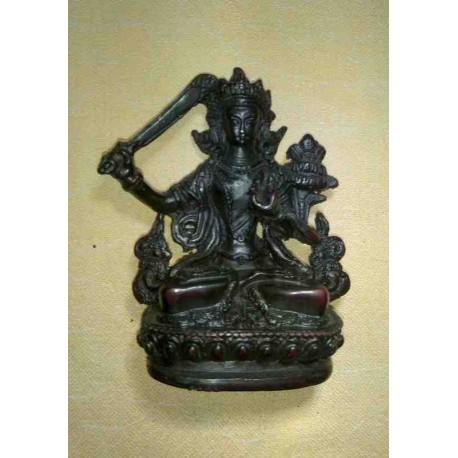No products
- English
- Ελληνικά
 View larger
View larger
- Remove this product from my favorite's list.
- Add this product to my list of favorites.
Manjushri Resin Statue From Nepal
New product
2 Items
Warning: Last items in stock!
Height 11cm .
Manjushri
Mañjuśrī is a bodhisattva associated with prajñā (insight) in Mahayana Buddhism. In Tibetan Buddhism, he is also a yidam. His name means "Gentle Glory" in Sanskrit.[1] Mañjuśrī is also known by the fuller name of Mañjuśrīkumārabhūta,[2] literally "Mañjuśrī, Still a Youth" or, less literally, "Prince Mañjuśrī".
Scholars have identified Mañjuśrī as the oldest and most significant bodhisattva in Mahāyāna literature.[3] Mañjuśrī is first referred to in early Mahayana sutras such as the Prajnaparamita sutras and through this association, very early in the tradition he came to symbolize the embodiment of prajñā (transcendent wisdom).
Mañjuśrī is depicted as a male bodhisattva wielding a flaming sword in his right hand, representing the realization of transcendent wisdom which cuts down ignorance and duality. The scripture supported by the padma (lotus) held in his left hand is a Prajñāpāramitā sūtra, representing his attainment of ultimate realization from the blossoming of wisdom. Mañjuśrī is often depicted as riding on a blue lion or sitting on the skin of a lion. This represents the use of wisdom to tame the mind, which is compared to riding or subduing a ferocious lion.
In Chinese and Japanese Buddhist art, Mañjuśrī's sword is sometimes replaced with a ruyi scepter, especially in representations of his Vimalakirti Sutra discussion with the layman Vimalakirti.[7] According to Berthold Laufer, the first Chinese representation of a ruyi was in an 8th-century Mañjuśrī painting by Wu Daozi, showing it held in his right hand taking the place of the usual sword. In subsequent Chinese and Japanese paintings of Buddhas, a ruyi was occasionally represented as a Padma with a long stem curved like a ruyi.[8]
He is one of the Four Great Bodhisattvas of Chinese Buddhism, the other three being Kṣitigarbha, Avalokiteśvara, and Samantabhadra. In China, he is often paired with Samantabhadra.
In Tibetan Buddhism, Mañjuśrī is sometimes depicted in a trinity with Avalokiteśvara and Vajrapāṇi.
Resin statue From Nepal .This type of work with resin is kind of Nepal trade mark ..They make mastrepieces in masks ,statues ,asstrays etc in different colours , and though is a synthetic material , it has a good feeling and looks natural .





